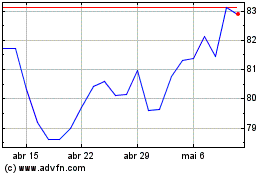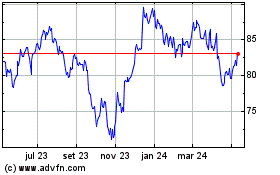A Comprehensive Guide to REIT ETFs - ETF News And Commentary
24 Março 2014 - 11:34AM
Zacks
The year 2013 has been an
unusual one for the Real Estate Investment Trust (REIT) industry
with stock prices of this special hybrid asset class seeing both
highs and lows. Particularly, the concerns surrounding the interest
rate environment emanating from the Federal Reserve’s economic
stimulus moves kept the industry in the headlines in the second
half of the year. (Read: Real Estate ETFs in Focus as rates turn
higher)
And for the first time in five years, the listed U.S. REIT stocks’
return underperformed the broader equity market as per the National
Association of Real Estate Investment Trusts (NAREIT). On a total
return basis in 2013, the FTSE NAREIT All REITs Index climbed just
3.2% compared to the S&P 500’s decent 32.4% run.
Finally, convinced by the consistent pickup in economic activity
and labor market improvement, the Fed started tapering its stimulus
in December. Further, in January, the Fed cut its monthly bond
buying to $65 billion from $75 billion in December. (Read: 2 Rising
ETFs with double digit yields)
In spite of this desperate stance taken by the Fed, the economic
data released earlier this year was not as robust as expected.
Coupled with the emerging economy woes, the benchmark indices in
fact became volatile resulting in a soft start to this year.
REITs Back in Focus
In this backdrop, the focus again shifted to REITs, which more
often than not, tend to perform better when stocks from other
industries are down. On a total return basis, the FTSE NAREIT All
REITs Index gained 3.4% in January, compared to the S&P 500’s
decline of 3.5%.
Further in February, with increased confidence regarding the
economic recovery, the FTSE NAREIT All REIT Index climbed 4.7%, a
notch higher than the 4.6% gain experienced by S&P 500. (Read:
Play rising rates with these ETFs)
While the gradual reduction in the Fed’s support could lead to
higher interest rates in the long run, thereby hurting the
rate-sensitive business of REITs, we believe that broader market
concerns will not cart off the prospects of gaining from portfolio
diversification that this distinct asset class offers.
REITs, which basically own and manage income-producing real estate
(such as apartments, offices, hotels, industrial or other
facilities or invest in mortgages or mortgage-backed securities
attached with properties), let its shareholders enjoy ownership
benefits of the real estate without actually becoming
landlords.
These assets perform differently based on individual market
dynamics. Therefore, investors have the opportunity to gain maximum
leverage from the changes seen time to time in performances by
these assets.
Consumer Confidence Growing
A decent GDP report and encouraging U.S. retail data clearly
indicate growing consumer confidence, which is further reinforced
by the Fed’s new-found faith in the economy. However, the
Consumer Confidence Index registered a moderate decline in February
to 78.1.
With consumer spending accounting for over two-third of the U.S.
economic activity, we believe that this is an opportune moment for
those companies that provide real estate support to the sectors
which directly benefit from these activities. Alongside, with the
Fed intending to keep the interest rates near zero despite the
tapering and until unemployment rate drops below 6.5%, REITs will
continue to benefit.
Dividends Still Are Key Attraction
Dividends continue to be the key attraction of this industry. With
the U.S. law requiring REITs to distribute 90% of their annual
taxable income in the form of dividends to shareholders,
yield-hungry investors still have a large appetite for such stocks.
This has enabled the industry to stand out and gain a footing over
the last 15–20 years.
As of Jan 31, the dividend yield of the FTSE NAREIT All REITs Index
was 4.16%. The yield of the FTSE NAREIT All Equity REITs Index was
3.65% while the FTSE NAREIT Mortgage REITs Index yielded 9.73%.
Clearly, the REITs continued to offer solid yields and outpaced the
2.09% dividend yield offered by the S&P 500 as of Jan 31.
Capital Access
Accessibility to capital is a prime factor in the REIT industry and
2013 has been a notable one from this angle. A total of $76.96
billion was raised by listed REITs compared to $73.33 billion in
the prior year. A solid IPO market in 2013 primarily made it
happen.
During the year, 19 IPOs helped in raising a total of $5.71
billion, marking the highest amount raised in the largest number of
IPOs since 2004. REITs have further raised $4.4 billion in initial,
debt and equity capital offerings in Jan 2014.
Exploring the Sector through ETFs
In this environment, we believe this is the right time to explore
the sector through ETFs so as to reap the benefits in a safer way
(See all Real Estate ETFs here). Considering the prospects for
return from dividend income and capital appreciation, we have
tracked the following REIT ETFs, which could be worth
considering:
Vanguard REIT ETF (VNQ)
The fund, launched over nine years ago, seeks investment results by
tracking the performance of the benchmark – MSCI US REIT Index –
which is used to gauge real estate stocks. The fund consists of 131
stocks, which acquire office buildings, hotels, and other real
property. The top three holdings are Simon Property Group
Inc. (SPG), Public Storage (PSA) and
Prologis, Inc. (PLD). It charges 10 basis points
in fees (as of May 28, 2013). VNQ has managed to attract $35.3
billion in assets under management till Jan 31, 2014.
iShares U.S. Real Estate ETF (IYR)
Launched in 2000, IYR follows the Dow Jones U.S. Real Estate Index
that measures the performance of the real estate industry of the
U.S. equity market. The fund comprises 101 stocks with top holdings
including Simon Property Group Inc., American Tower
Corporation (AMT) and Crown Castle International
Corp. (CCI). The fund’s expense ratio is 0.45% (as of Dec
31, 2013) and the 12-month yield is 3.65% (as of Jan 31, 2014). It
has $4.7 billion in assets under management as of Mar 6, 2014.
SPDR Dow Jones REIT ETF (RWR)
Functioning since 2001, RWR seeks investment results of the Dow
Jones U.S. Select REIT Index. The fund consists of 87 stocks that
have equity ownership and operate commercial real estate, with the
top holdings being Simon Property Group Inc., Public Storage and
Prologis Inc. The fund’s expense ratio is 0.25% (as of Mar 7, 2014)
and dividend yield is 3.06% (as of Mar 5, 2014). RWR has about $2.4
billion in assets under management (as of Mar 5, 2014).
Schwab US REIT ETF (SCHH)
This fund debuted in 2011 and tracks the total return of the Dow
Jones U.S. Select REIT Index. The fund consists of 87 stocks that
own and operate commercial real estates. The top three holdings are
Simon Property Group Inc., Public Storage and Prologis Inc. It
charges 7 basis points in fees (as of Feb 28, 2014), while the
trailing twelfth month distribution yield is 2.37%. SCHH boasts
$786.7 million in assets under management (till Feb 28, 2014).
First Trust S&P REIT Index Fund (FRI)
Launched in May 2007, FRI is an ETF that seeks investment results
of the S&P United States REIT Index that gauges the U.S. REIT
market and retains consistency, which depicts the overall market
composition. The fund comprises 140 stocks with the top holdings
being Simon Property Group Inc., Public Storage and Prologis Inc.
The fund’s net expense ratio is 0.50% (as of Dec 31, 2013) and the
12-month distribution rate is 2.98% while index yield is 3.97% as
of Jan 31, 2014. FRI has about $146.6 million in net assets under
management (as of Mar 5, 2014).
Want the latest recommendations from Zacks Investment Research?
Today, you can download 7 Best Stocks for the Next 30
Days. Click to get this free report
>>
FT-SP REIT IDX (FRI): ETF Research Reports
ISHARS-US REAL (IYR): ETF Research Reports
SPDR-DJ W REIT (RWR): ETF Research Reports
SCHWAB-US REIT (SCHH): ETF Research Reports
VIPERS-REIT (VNQ): ETF Research Reports
To read this article on Zacks.com click here.
Zacks Investment Research
Want the latest recommendations from Zacks Investment Research?
Today, you can download 7 Best Stocks for the Next 30 Days. Click
to get this free report
Vanguard Real Estate ETF (AMEX:VNQ)
Gráfico Histórico do Ativo
De Dez 2024 até Jan 2025

Vanguard Real Estate ETF (AMEX:VNQ)
Gráfico Histórico do Ativo
De Jan 2024 até Jan 2025
